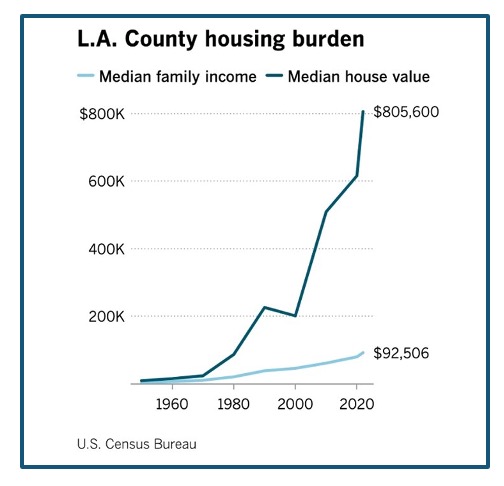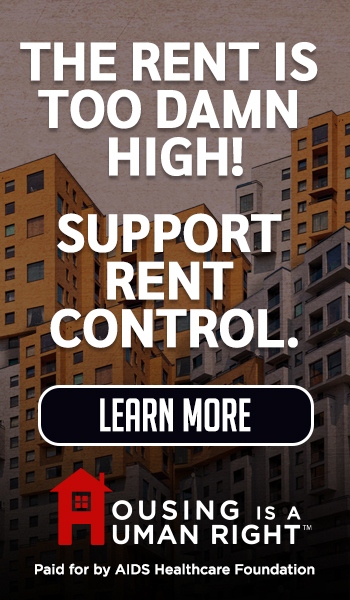Comments
PLANNING WATCH - The race is on to cram new, small, high-density apartments into neighborhoods of single-family houses in Los Angeles. The cramming device is the Regional Housing Needs Assessment (RHNA) for Los Angeles. RHNA is the weapon of choice of real estate developers to change the building regulations in affluent neighborhoods. Why? Because it creates a credible cover story for them to legally build highly profitable, small, and under-parked apartments in these up-scale neighborhoods.
Unfortunately for these commercial interests and their lobbyists, this sleight-of-hand is meeting stiff opposition. Some groups want to protect their own turf and force new apartment houses, like the one above, to transit corridors. Others disagree that Los Angeles neighborhoods need to be up-zoned to ensure that the city has sufficient zoning to reduce homelessness. This group also contends that LA already has sufficient zoning, and that homelessness and overcrowding is caused by declining incomes, not an alleged shortage of rental houses and apartments.
If we look deeper into the State-imposed RHNA mandates, we discover the following:
Housing is a vague term. It can mean houses, large apartments that were once built throughout Los Angeles, or new, small, expensive apartments. While most Angelenos prefer to live in a house, developers now build small, expensive apartments and McMansions. As a result, those desperate for a place are forced to live in a small apartment or McMansion. Otherwise they must live in overcrowded conditions, become homeless, or move to cheaper housing markets. This, in fact, is why LA’s population is steadily declining.
State RHNA planners ignored conflicting data. For example, the Final Environmental Impact Report for LA’s General Plan Framework Element reported that the buildout of LA’s existing zoning would produce a population of 7,191,000 people. This would not require any zoning increases, even though this is exactly what State-imposed housing mandates claim.
When neighborhoods are up-zoned, City Hall cannot force private developers to invest in housing. If new apartment projects are not sufficiently profitable, investors will not build them, and the additional zoning capacity sits unutilized. Since upzoning rarely results in affordable apartments or homes, this undermines the intended purpose of reducing homelessness by increasing the amount of new housing through up-zoning.
LA’s City Hall does not know if new apartments are occupied by low-income tenants. This is because no City department verifies tenant incomes and rents charged. The best the City can do is monitor the theoretical increases in zoned capacity and issued building permits, not housing units that actually charge affordable rents to vetted tenants.

Housing data from the City and County of Los Angeles does not measure affordability. Yet, the table above reveals that price of housing in Los Angeles has increased much faster than incomes. This discrepancy has forced people to live in expensive apartments, cars, or outside. As result, despite LA’s January 2025 wildfires destroying 12,000 homes and apartments, thousands of apartments and houses still sit vacant because potential tenants cannot afford them.
In addition, some unscrupulous landlords illegally divide bedrooms in half until they find someone to rent the entire unit.
PowerPoint Presentations: This outcome is confirmed by Santa Monica analyst Mark L. Verville in several PowerPoint presentations recently made to Catalysts for Local Control. In these presentations, he made the following points:
- RHNA appears to be only tangentially related to the affordability problems being used as its justification.
- RHNA’s Affordable Housing mandates are unfunded despite housing affordability being the core RHNA justification.
- RHNA Affordable Housing requirements (are) almost entirely dependent on an inclusionary market rate strategy.
(Translation: Affordable housing construction is dependent on bonuses granted to private sector housing investors.)
Conclusion: Why should anyone be surprised that State-imposed RHNA requirements have resulted in more homelessness in cities like Los Angeles? After all, the RHNA solution to reduce homelessness – trickle-down market housing -- is based on the false claim that homelessness is caused by a “housing” shortage, not increasing economic inequality.
(Dick Platkin ([email protected]) is a retired LA city planner, who reports on local planning issues. He is a board member of United Neighborhoods for Los Angeles (UN4LA). Previous columns are available at the CityWatchLA archives.)






